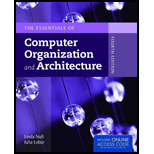
Explanation of Solution
Explanation:
The given mathematical expression is
The above expression is evaluated using instructions with required operands.
If the number of operands increases then, the instructions required to complete the task decreases.
Three-address machine:
The number of instructions can be accommodated is 3.
The first operand stores the output obtained whereas the second and the third operands stores the required input.
ADD and MUL are used for representing addition and multiplication operations respectively.
The given mathematical expression
ADD R1, B, C
ADD R2, D, E
MUL A, R1, R2
Here, the inputs stored in B and C is added and the output is stored in R1 and the inputs stored in D and E is added and the output is stored in R2. The values stored in R1 and R2 are multiplied and final output is stored in A.
Therefore, the mathematical expression
Two-address machine:
The number of instructions can be accommodated is 2.
The first operand stores the output obtained whereas the second operand stores the required input.
ADD and MUL are used for representing addition and multiplication operations respectively and LOAD is used for loading the required value.
The given mathematical expression
LOAD R1, B
ADD R1, C
LOAD R2, D
ADD R2, E
MUL R1, R2
STORE A, R1
Here, the operand B is loaded and the input is stored in R1. It is added with the value stored in the operand C and the output is stored R1. The operand D is loaded and the input is stored in R2. It is added with the value stored in the operand E and the output is stored R2. The values stored in R1 and R2 are multiplied and finally the result is stored in the operand A.
Therefore, the mathematical expression
Want to see the full answer?
Check out a sample textbook solution
Chapter 5 Solutions
The Essentials of Computer Organization and Architecture
- You have made the Web solution with Node.js. please let me know what problems and benefits I would experience while making the Web solution here, as compared to any other Web solution you have developed in the past. what problems and benefits/things to keep in mind as someone just learningarrow_forwardPHP is the server-side scripting language. MySQL is used with PHP to store all the data. EXPLAIN in details how to install and run the PHP/MySQL on your computer. List the issues and challenges I may encounter while making this set-up? why I asked: I currently have issues logging into http://localhost/phpmyadmin/ and I tried using the command prompt in administrator to reset the password but I got the error LOCALHOST PORT not found.arrow_forwardHTML defines content, CSS defines layout, and JavaScript adds logic to the website on the client side. EXPLAIN IN DETAIL USING an example.arrow_forward
- show all the workarrow_forwardList down the strenghts and weaknesses of your team project for Capsim Simulation? Explan.arrow_forwardCapsim Team PowerPoint Presentations - Slide Title: Key LearningsWhat were the key learnings that you discovered as a team through your Capsim simulation?arrow_forward
 Database System ConceptsComputer ScienceISBN:9780078022159Author:Abraham Silberschatz Professor, Henry F. Korth, S. SudarshanPublisher:McGraw-Hill Education
Database System ConceptsComputer ScienceISBN:9780078022159Author:Abraham Silberschatz Professor, Henry F. Korth, S. SudarshanPublisher:McGraw-Hill Education Starting Out with Python (4th Edition)Computer ScienceISBN:9780134444321Author:Tony GaddisPublisher:PEARSON
Starting Out with Python (4th Edition)Computer ScienceISBN:9780134444321Author:Tony GaddisPublisher:PEARSON Digital Fundamentals (11th Edition)Computer ScienceISBN:9780132737968Author:Thomas L. FloydPublisher:PEARSON
Digital Fundamentals (11th Edition)Computer ScienceISBN:9780132737968Author:Thomas L. FloydPublisher:PEARSON C How to Program (8th Edition)Computer ScienceISBN:9780133976892Author:Paul J. Deitel, Harvey DeitelPublisher:PEARSON
C How to Program (8th Edition)Computer ScienceISBN:9780133976892Author:Paul J. Deitel, Harvey DeitelPublisher:PEARSON Database Systems: Design, Implementation, & Manag...Computer ScienceISBN:9781337627900Author:Carlos Coronel, Steven MorrisPublisher:Cengage Learning
Database Systems: Design, Implementation, & Manag...Computer ScienceISBN:9781337627900Author:Carlos Coronel, Steven MorrisPublisher:Cengage Learning Programmable Logic ControllersComputer ScienceISBN:9780073373843Author:Frank D. PetruzellaPublisher:McGraw-Hill Education
Programmable Logic ControllersComputer ScienceISBN:9780073373843Author:Frank D. PetruzellaPublisher:McGraw-Hill Education





